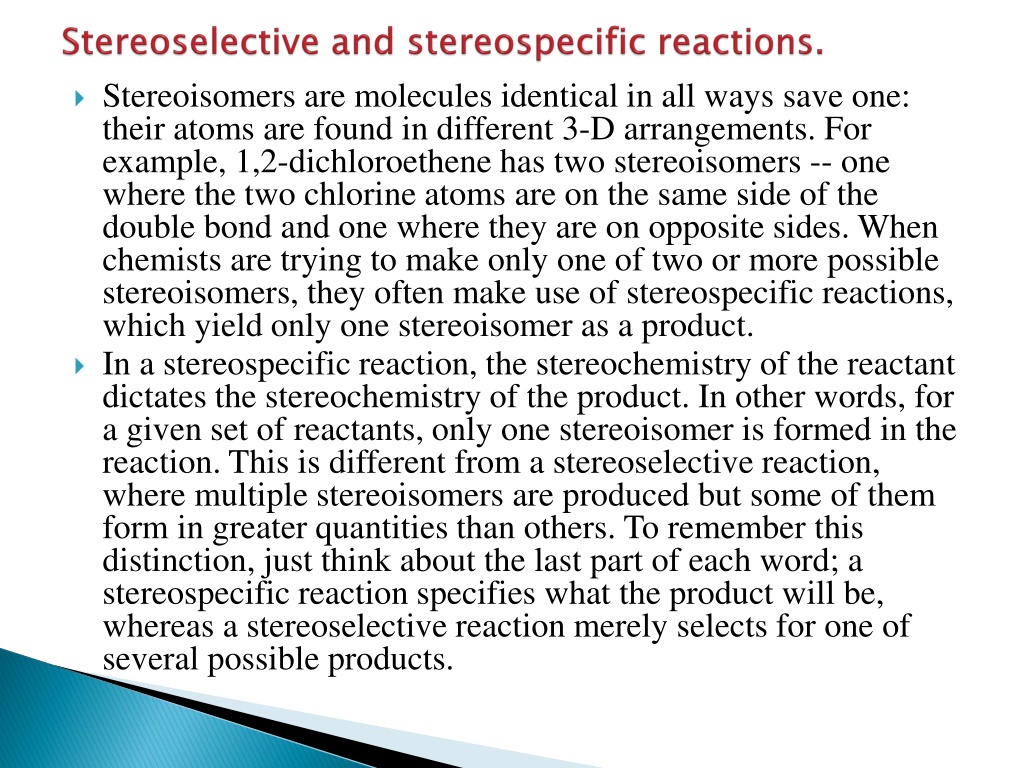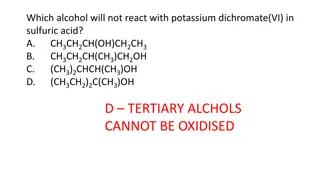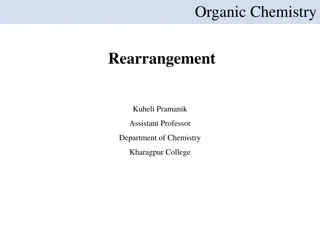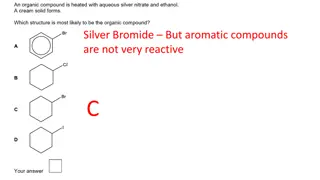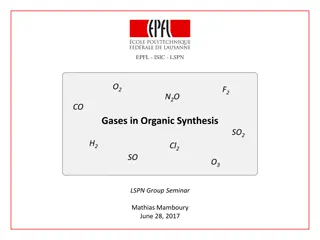Understanding Stereospecific and Stereoselective Reactions in Organic Chemistry
Stereoisomers are molecules that differ only in their 3-D arrangements, with stereoisomers having identical atoms but different spatial orientations. Chemists utilize stereospecific reactions to produce only one stereoisomer, determined by the reactant's stereochemistry. Conversely, stereoselective reactions yield multiple stereoisomers, with some formed in higher quantities than others. Examples and distinctions between stereospecific and stereoselective reactions are illustrated with organic compounds like 2-butene and 2,3-dibromobutane.
Download Presentation

Please find below an Image/Link to download the presentation.
The content on the website is provided AS IS for your information and personal use only. It may not be sold, licensed, or shared on other websites without obtaining consent from the author. Download presentation by click this link. If you encounter any issues during the download, it is possible that the publisher has removed the file from their server.
E N D
Presentation Transcript
Stereoisomers are molecules identical in all ways save one: their atoms are found in different 3-D arrangements. For example, 1,2-dichloroethene has two stereoisomers -- one where the two chlorine atoms are on the same side of the double bond and one where they are on opposite sides. When chemists are trying to make only one of two or more possible stereoisomers, they often make use of stereospecific reactions, which yield only one stereoisomer as a product. In a stereospecific reaction, the stereochemistry of the reactant dictates the stereochemistry of the product. In other words, for a given set of reactants, only one stereoisomer is formed in the reaction. This is different from a stereoselective reaction, where multiple stereoisomers are produced but some of them form in greater quantities than others. To remember this distinction, just think about the last part of each word; a stereospecific reaction specifies what the product will be, whereas a stereoselective reaction merely selects for one of several possible products.
Stereoselective and stereospecific reactions. * * CH3CH=CHCH3 + Br2 CH3CHCHCH3 Br Br 2-butene 2,3-dibromobutane 2 geometric isomers cis- and trans- meso- 3 stereoisomers (S,S)-, (R,R)-, and (R,S)-
H CH3 CH3 CH3 \ / \ / C = C C = C / \ / \ CH3 H H H trans-2-butene cis-2-butene CH3 CH3 CH3 H Br Br H H Br Br H H Br H Br CH3 (S,S) CH3 CH3 (R,R) meso
CH3 H CH3 \ / H Br C = C + Br2 / \ H Br CH3 H CH3 trans-2-butene meso-2,3-dibromobutane only product A reaction that yields predominately one stereoisomer (or one pair of enantiomers) of several diastereomers is called a stereoselective reaction. In this case the meso- product is produced and not the other two diastereomers.
CH3 CH3 H Br Br H H H \ / C = C + Br2 + / \ CH3 CH3 CH3 CH3 cis-2-butene (S,S)- & (R,R)-2,3-dibromobutane racemic modification only products Br H H Br A reaction in which stereochemically different molecules react differently is called a stereospecific reaction. In this case the cis- and trans- stereoisomers give different products.
The fact that the addition of halogens to alkenes is both stereoselective and stereospecific gives us additional information about the stereochemistry of the addition and the mechanism for the reaction. Thus the addition of bromine is a stereospecific reaction the product obtained from addition to the cis isomer is different from the product obtained from addition to the trans isomer. It is also a stereoselective reaction because all possible isomers are not formed.
anti-addition C C C C syn-addition C C C C
CH3 CH3 CH3 Br2 H Br H Br H Br H3C CC H + H Br H CH3 CH3 CH3 Br2 H H H Br Br H3C CC H CH3 CH3 Is the addition of Br2syn or anti?
H X H X \ / | H C = C H C C CH3 anti-addition of X2 / \ CH3 | CH3 X CH3 X to the cis-isomer Note: must rotate about C-C to get to the Fischer projection! X CH3 | H H X H C C CH3 X C C H X H CH3 | | | X CH3 CH3 H X CH3
H X CH3 X \ / | CH3 C = C H C C H anti-addition of X2 / \ CH3 | to the trans-isomer CH3 X H X Note: must rotate about C-C to get to the Fischer projection! X CH3 | CH3H H H C C H X C C X H X CH3 | | | X CH3 CH3 H X CH3
H CH3 Br2 H3C H H H Br H H3C Br H3C Br Br Br Br H anti- CH3 H3C H3C H H3C H H H3C H CH3 H Br2 H3C Br H H Br Br H3C Br Br H CH3 anti- H CH3 H CH3 H3C Br rotate about C2-C3 to get to Fischer projection!
Hydroxylation of alkenes: * * CH3CH=CHCH3 + KMnO4 CH3CH-CHCH3 OH OH 2-butene 2,3-butanediol 2 geometric isomers 3 stereoisomers
cis-2-butene + KMnO4 2,3-butanediol mp 34oC trans-2-butene + KMnO4 2,3-butanediol mp 19oC 2,3-butanediol ( mp 19oC ) is separable into enantiomers. CH3 CH3 CH3 H OH HO H H OH HO H H OH H OH CH3 (S,S) CH3 CH3 meso (R,R) mp 19oC mp 34oC
cis-2-butene + KMnO4meso-2,3-dihydroxybutane mp 34o CH3 H3C CH3 H OH C C H H H OH CH3 trans-2-butene + KMnO4 (S,S) & (R,R)-2,3-dihydroxybutane mp 19o CH3 CH3 H3C H C C H H OH + HO H HO H H OH CH3 CH3 CH3 stereoselective and stereospecific
H O O CH3 OH OH \ / | | C = C H C C CH3syn-oxidation of / \ CH3 H the trans-isomer CH3 H Note: must rotate about C-C to get to the Fischer projection! OH OH CH3 | | H OH H C C CH3 HO C C H HO H CH3 H | | CH3 CH3 H OH CH3
H O O H OH OH \ / | | C = C H C C H syn-oxidation of / \ CH3 CH3 the cis-isomer CH3 CH3 Note: no rotation necessary to get to Fischer projection! OH OH CH3 | | H H H C C H HO C C OH H OH CH3 CH3 | | CH3 CH3 H OH CH3
cis-2-butene + HCO3H 2,3-butanediol mp 19oC trans-2-butene + HCO3H 2,3-butanediol mp 34oC 2,3-butanediol mp 19oC is separable into enantiomers. CH3 CH3 CH3 H OH HO H H OH HO H H OH H OH CH3 (S,S) CH3 CH3 meso (R,R) mp 19oC mp 34oC
Oxidation with KMnO4syn-oxidation cis-2-butene meso-2,3-dihydroxybutane trans-butene (S,S)- & (R,R)-2,3-dihydroxybutane Oxidation with HCO2OH gives the opposite cis-2-butene (S,S)- & (R,R)-2,3-dihydroxybutane trans-2-butene meso-2,3-dihydroxybutane Oxidation with HCO2OH is anti-oxidation.
| | C C hydroxylation with KMnO4 | | is syn- because of an intermediate O O permanganate addition product. Mn O O | | C C O is anti- because of an intermediate epoxide. hydroxylation with HCO2OH
* * CH2-CH-CH-CH=O | | | OH OH OH Four carbon sugar, an aldotetrose. Two chiral centers, four stereoisomers
CHO CHO H OH HO H H OH HO H CH2OH CH2OH D-erythrose L-erythrose CHO CHO HO H H OH H OH HO H CH2OH CH2OH D-threose L-threose
X X X X erythro- X X X X threo-
* * C6H5CHCHC6H5 + KOH(alc) C6H5CH=CC6H5 Br CH3 CH3 1-bromo-1,2-diphenylpropane 1,2-diphenylpropene 4 stereoisomers 2 stereoisomers (E)- & (Z)- dehydrohalogenation of an alkyl halide via E2 mechanism
C6H5 C6H5 CH3 H H CH3 CH3 H H CH3 Br H H Br H Br Br H C6H5 C6H5 C6H5 erythro- threo- C6H5 C6H5 C6H5 C = C C = C / \ / \ H C6H5 H CH3 C6H5 CH3 C6H5 C6H5 \ / \ / (E)- (Z)-
C6H5 C6H5 CH3 H H Br H H Br CH3 KOH(alc) C6H5 erythro- C6H5 C6H5 C6H5 \ / C = C / \ H CH3 (Z)-
C6H5 C6H5 CH3 H H CH3 H Br Br H KOH(alc) C6H5 C6H5 threo- C6H5 CH3 \ / C = C / \ H C6H5 (E)-
E2 is both stereoselective and stereospecific. 100% anti-elimination of the H & Br: C6H5 CH3 H CH3 C6H5 C C Br H | C6H5 C = C H / \ C6H5 C6H5 C6H5 HO- Br | CH3 H H \ / erythro- (Z)-
C6H5 CH3 H CH3 C6H5 C C H Br | H C = C H / \ C6H5 C6H5 CH3 HO- Br | CH3 C6H5 C6H5 \ / threo- (E)- Once again, you must rotate about the C C bond in the Fischer projection to get the H & Br anti to one another.
E2 is an anti-elimination. The hydrogen and the halogen must be on opposite sides of the molecule before the E2 elimination can take place. This makes sense as both the base and the leaving group are negatively charged. Therefore they would try to be as far apart as possible. In addition, the leaving group is large and there is more room for the removal of the adjacent proton if it is on the opposite side from the leaving group.
Cis-anti-threo Trans-anti-erythro Addition of halogens to alkenes anti-addition Cis-syn-erythro Trans-syn-threo Hydoxylation with KMnO4 syn-oxidation Cis-anti-threo Trans-anti-erythro Hydroxylation with HCO2OH anti-oxidation Erythro-anti-cis Threo-anti-trans Dehydrohalogena tion of alkyl halides E2 anti-elimination
One way to determine what stereoisomers are obtained from many reactions that create a product with two asymmetric carbons is the mnemonic CIS-SYN-ERYTHRO, which is easy to remember because all three terms mean on the same side. You can change any two of the terms but you can t change just one. (For example, TRANS- ANTI-ERYTHRO, and CIS-ANTI-THREO are allowed, but TRANS- SYN-ERYTHRO is not allowed.) So if you have a trans reactant that undergoes addition of Br2 (which is anti), the erythro products are obtained.
